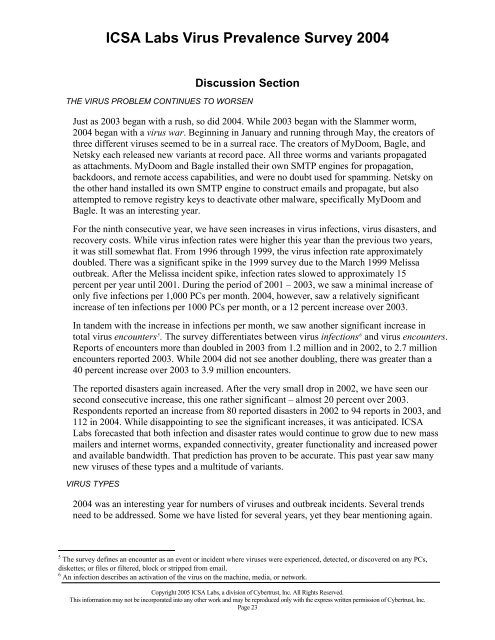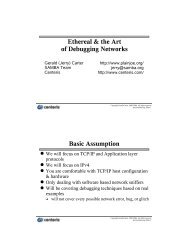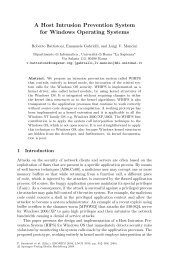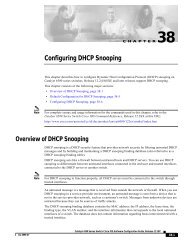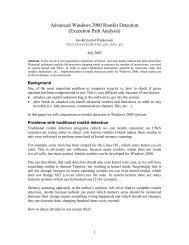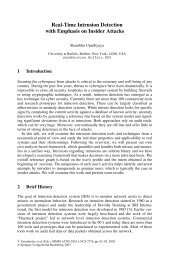ICSA Labs 10th Annual Virus Prevalence Survey 2004.pdf - Craig ...
ICSA Labs 10th Annual Virus Prevalence Survey 2004.pdf - Craig ...
ICSA Labs 10th Annual Virus Prevalence Survey 2004.pdf - Craig ...
- No tags were found...
Create successful ePaper yourself
Turn your PDF publications into a flip-book with our unique Google optimized e-Paper software.
<strong>ICSA</strong> <strong>Labs</strong> <strong>Virus</strong> <strong>Prevalence</strong> <strong>Survey</strong> 2004Discussion SectionTHE VIRUS PROBLEM CONTINUES TO WORSENJust as 2003 began with a rush, so did 2004. While 2003 began with the Slammer worm,2004 began with a virus war. Beginning in January and running through May, the creators ofthree different viruses seemed to be in a surreal race. The creators of MyDoom, Bagle, andNetsky each released new variants at record pace. All three worms and variants propagatedas attachments. MyDoom and Bagle installed their own SMTP engines for propagation,backdoors, and remote access capabilities, and were no doubt used for spamming. Netsky onthe other hand installed its own SMTP engine to construct emails and propagate, but alsoattempted to remove registry keys to deactivate other malware, specifically MyDoom andBagle. It was an interesting year.For the ninth consecutive year, we have seen increases in virus infections, virus disasters, andrecovery costs. While virus infection rates were higher this year than the previous two years,it was still somewhat flat. From 1996 through 1999, the virus infection rate approximatelydoubled. There was a significant spike in the 1999 survey due to the March 1999 Melissaoutbreak. After the Melissa incident spike, infection rates slowed to approximately 15percent per year until 2001. During the period of 2001 – 2003, we saw a minimal increase ofonly five infections per 1,000 PCs per month. 2004, however, saw a relatively significantincrease of ten infections per 1000 PCs per month, or a 12 percent increase over 2003.In tandem with the increase in infections per month, we saw another significant increase intotal virus encounters 5 . The survey differentiates between virus infections 6 and virus encounters.Reports of encounters more than doubled in 2003 from 1.2 million and in 2002, to 2.7 millionencounters reported 2003. While 2004 did not see another doubling, there was greater than a40 percent increase over 2003 to 3.9 million encounters.The reported disasters again increased. After the very small drop in 2002, we have seen oursecond consecutive increase, this one rather significant – almost 20 percent over 2003.Respondents reported an increase from 80 reported disasters in 2002 to 94 reports in 2003, and112 in 2004. While disappointing to see the significant increases, it was anticipated. <strong>ICSA</strong><strong>Labs</strong> forecasted that both infection and disaster rates would continue to grow due to new massmailers and internet worms, expanded connectivity, greater functionality and increased powerand available bandwidth. That prediction has proven to be accurate. This past year saw manynew viruses of these types and a multitude of variants.VIRUS TYPES2004 was an interesting year for numbers of viruses and outbreak incidents. Several trendsneed to be addressed. Some we have listed for several years, yet they bear mentioning again.5 The survey defines an encounter as an event or incident where viruses were experienced, detected, or discovered on any PCs,diskettes; or files or filtered, block or stripped from email.6 An infection describes an activation of the virus on the machine, media, or network.Copyright 2005 <strong>ICSA</strong> <strong>Labs</strong>, a division of Cybertrust, Inc. All Rights Reserved.This information may not be incorporated into any other work and may be reproduced only with the express written permission of Cybertrust, Inc.Page 23


